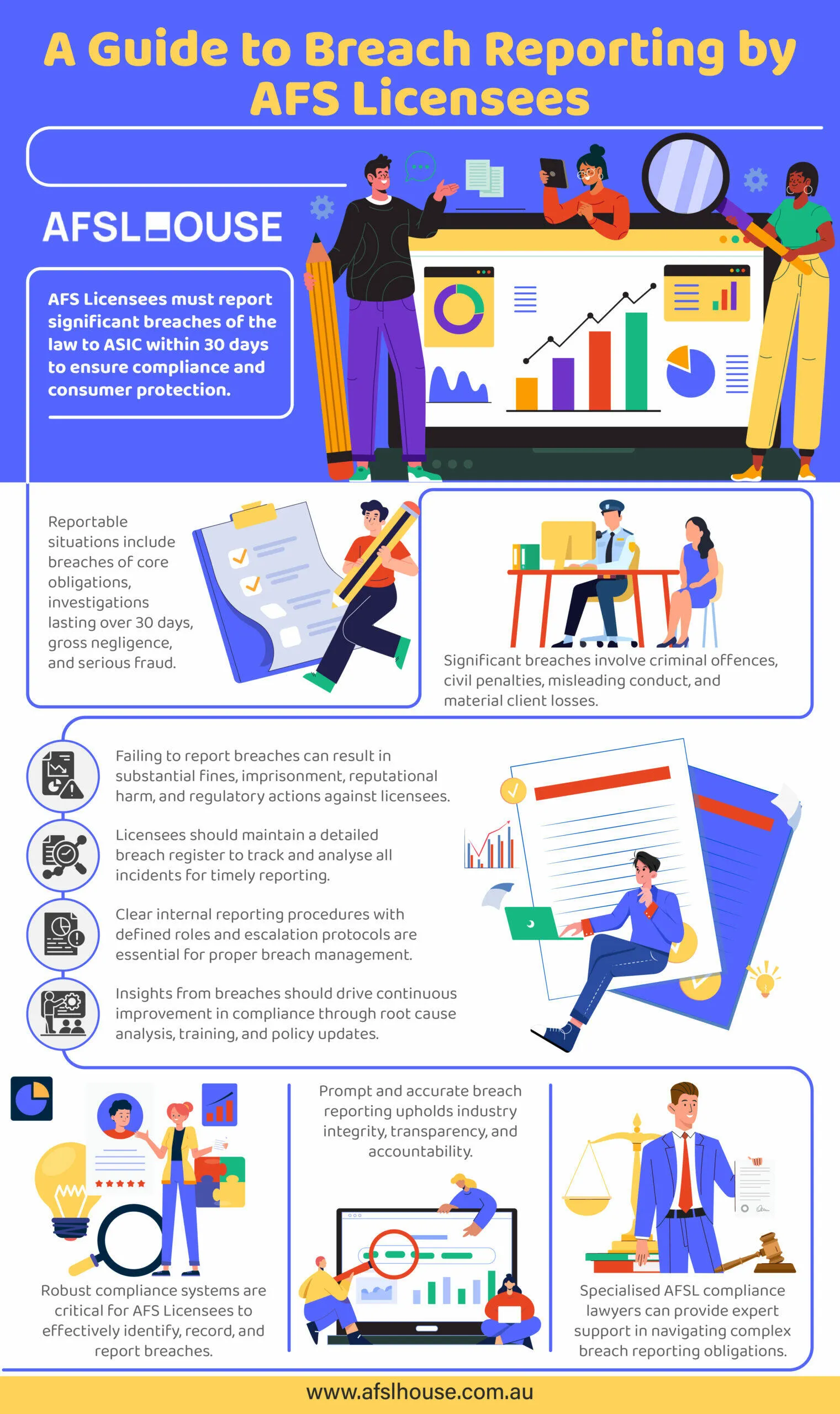Introduction
Breach reporting is a fundamental obligation for Australian Financial Services Licensees (AFS Licensees) under the Corporations Act 2001 (Cth). This requirement ensures that Licensees promptly notify the Australian Securities and Investments Commission (ASIC) of significant breaches, thereby upholding market integrity and protecting consumer interests.
For AFS Licensees, adhering to breach reporting obligations is essential not only for legal compliance but also for identifying and addressing systemic issues within their organisations. This guide provides comprehensive insights and practical guidance on fulfilling breach reporting requirements, understanding reportable situations, and establishing robust compliance systems.

Get Your Free Initial Consultation
Consult with one of our experienced ACL & AFSL Lawyers today.
Understanding Breach Reporting Obligations
Core Obligations of AFS Licensees
AFS licensees have fundamental responsibilities under the Corporations Act 2001 (Cth), which include the obligation to self-report breaches to the Australian Securities and Investments Commission (ASIC). This obligation is specifically outlined in Regulatory Guide 78 (RG 78) and mandates that licensees must report certain breaches of the law, particularly those that are significant.
The core obligations include:
- Compliance with Financial Services Laws: Licensees must ensure that they comply with all applicable financial services laws, a key part of which involves maintaining and demonstrating organisational competence, as defined under s912A of the Corporations Act 2001 (Cth).
- Reporting Significant Breaches: Licensees are required to report any significant breach or likely significant breach of their core obligations to ASIC within 30 calendar days of becoming aware of the breach.
- Maintaining Adequate Resources: Licensees must have adequate resources to provide the financial services covered by their licence, ensuring compliance with their obligations.
Purpose of Breach Reporting
The purpose of breach reporting is to enhance the integrity of the financial services industry and protect consumers. By requiring AFS licensees to report breaches, ASIC can monitor compliance and take necessary regulatory actions when significant non-compliance is detected.
Key purposes of breach reporting include:
- Early Detection of Non-Compliance: Reporting allows ASIC to identify and address significant non-compliant behaviours early, which can prevent further issues from arising.
- Consumer Protection: Timely reporting helps protect consumers from potential harm that may arise from breaches of financial services laws.
- Improving Industry Standards: By holding licensees accountable for their compliance, breach reporting contributes to raising overall industry standards and practices.
Through these mechanisms, breach reporting serves as a critical component of the regulatory framework governing AFS licensees, ensuring that they operate within the law and uphold consumer trust in the financial services sector.
Speak with an ACL & AFSL Lawyer Today
Request a Consultation to Get Started.
What Constitutes a Reportable Situation
AFS licensees must report specific types of conduct to ASIC as outlined in Regulatory Guide 78 (RG 78). These include significant breaches of core obligations, ongoing investigations into potential breaches, and additional reportable situations that involve severe misconduct.
Significant Breaches of Core Obligations
A significant breach under RG 78 includes any breach of a core obligation that is either deemed significant by law or assessed as significant by the licensee. Examples of significant breaches are:
- Criminal Offences: Breaches that constitute the commission of an offence punishable by imprisonment for three months or more if involving dishonesty, or 12 months or more in other cases.
- Civil Penalty Provisions: Contraventions of civil penalty provisions that are not exempted under the regulations or specific ASIC instruments.
- Misleading or Deceptive Conduct: Breaches of provisions related to misleading or deceptive conduct under relevant sections of the Corporations Act 2001 (Cth) or Australian Securities and Investments Commission Act 2001 (Cth).
- Material Loss or Damage: Conduct that results, or is likely to result, in material loss or damage to clients, including scenarios like overcharging or incorrect fee application.
These breaches are automatically considered significant and must be reported without additional assessment.
Reportable Investigations
An investigation becomes a reportable situation when it continues for more than 30 days and is focused on determining whether a significant breach or likely breach of a core obligation has occurred. The key points regarding reportable investigations include:
- Duration: If an investigation into a potential breach lasts longer than 30 days, it must be reported to ASIC as a reportable situation.
- Commencement: The investigation is considered reportable from the 31st day of its duration, and a report must be lodged within 30 days thereafter.
- Outcome Reporting: If the investigation concludes that there is no significant breach, this outcome must also be reported to ASIC within the required timeframe.
For instance, if a licensee begins an investigation into client complaints regarding potential overcharging and this investigation continues for over 30 days, the licensee is obligated to report this situation to ASIC.
Additional Reportable Situations
Beyond significant breaches and reportable investigations, RG 78 also requires the reporting of additional severe misconduct, which includes:
- Gross Negligence: Conduct that demonstrates a blatant disregard for the required standards of care in providing financial services.
- Serious Fraud: Any intentional wrongdoing that leads to significant financial loss or damage, such as embezzlement or deceitful practices. This includes breaches that meet the statutory definitions of serious fraud under the Corporations Act 2001 (Cth).
These additional situations must be reported to ASIC irrespective of their significance, ensuring comprehensive oversight of the financial services industry.
Get Your Free Initial Consultation
Consult with one of our experienced ACL & AFSL Lawyers today.
When and How to Report
Understanding the appropriate timing and method for reporting breaches is crucial for compliance and maintaining trust with regulators and clients. Proper adherence ensures that your organisation meets its legal obligations and helps mitigate potential penalties.
Reporting Timelines
Reportable situations must be reported to ASIC within 30 calendar days of knowing, or being reckless regarding whether, a breach has occurred. This timeframe is strict and non-negotiable, emphasising the importance of prompt action.
Key points to consider regarding reporting timelines include:
- Immediate Action Required: Do not delay reporting until a breach is fully resolved. The obligation starts when you first become aware of the breach.
- Extended Reporting Period in Specific Cases: In limited circumstances where multiple reportable situations share similar root causes, you may have up to 90 days to report these additional situations after the initial 30-day period.
- Consistent Compliance: Regular monitoring and timely identification of breaches are essential to ensure reports are submitted within the required deadlines.
Failure to adhere to these timelines can result in significant civil and criminal penalties, underscoring the necessity of a proactive compliance approach.
Report Submission Process
Submitting a breach report involves a structured process to ensure all necessary information is accurately conveyed to ASIC. The process includes using the ASIC Regulatory Portal and following the prescribed reporting format.
Steps involved in the report submission process:
- Access the ASIC Regulatory Portal: All breach reports must be submitted through the ASIC Regulatory Portal.
- Complete the Prescribed Forms: Use the designated forms provided within the portal to ensure consistency and compliance. These forms capture essential details about the breach, including its nature, impact, and the circumstances surrounding its occurrence.
- Provide Accurate Information: Accuracy is paramount. Ensure that all information entered is correct and reflects the true extent of the breach. Misreporting can lead to further legal complications and undermine your compliance efforts.
- Submit Supporting Documentation: While the primary submission is done through structured forms, include any additional documentation that can support your report. This may include internal investigation findings, evidence of the breach, and remediation actions taken.
- Track and Monitor the Report: After submission, use the portal to track the status of your report. The portal allows for ongoing communication with ASIC regarding any additional information or actions required.
- Assign Responsible Personnel: Ensure that individuals responsible for managing breach reports are clearly identified and have the authority to act on your behalf within the portal. This ensures efficient handling and follow-up of breaches.
By following this structured approach, AFS licensees can effectively fulfil their reporting obligations, maintain regulatory compliance, and uphold industry standards.
Speak with an ACL & AFSL Lawyer Today
Request a Consultation to Get Started.
Consequences of Non-Compliance
Failing to comply with breach reporting obligations can lead to severe legal repercussions for Australian Financial Services (AFS) licensees. Under Regulatory Guide 78, non-compliance is classified as an offence, exposing licensees to both civil and criminal penalties.
Civil Penalties
The civil penalties for not reporting breaches are substantial. For individuals, the maximum penalty is the greater of AUD 5,000 or three times the benefit derived and detriment avoided from the breach. For corporations, penalties can escalate to the greatest of AUD 50,000, three times the benefit derived and detriment avoided, or 10% of the annual turnover for the 12-month period ending at the breach’s occurrence.
Criminal Penalties
In addition to civil sanctions, criminal penalties may also apply. The maximum penalties include fines of up to AUD 240,000 for individuals and AUD 2,400,000 for corporations. Furthermore, breaches can result in imprisonment for up to two years or both fines and imprisonment, depending on the offence’s severity and nature.
Reputational Damage
Beyond financial and legal consequences, failing to report breaches can severely damage a licensee’s reputation. This erosion of trust can impact client relationships and the overall standing of the licensee within the financial services industry.
Regulatory Actions
ASIC may also take additional regulatory actions, such as suspending or cancelling Australian Financial Services Licences, imposing administrative measures to ensure future compliance or requiring enhanced supervisory arrangements. These actions aim to protect consumers and maintain industry standards.
Importance of Compliance
Given the significant consequences outlined, it is crucial for AFS licensees to adhere strictly to their breach reporting obligations. Timely and accurate reporting not only ensures legal compliance but also upholds the integrity and trustworthiness of the financial services sector.
Failing to report breaches undermines regulatory frameworks designed to safeguard consumers and uphold industry standards. Therefore, licensees must prioritise establishing robust compliance systems to detect, investigate, and report breaches promptly.
Get Your Free Initial Consultation
Consult with one of our experienced ACL & AFSL Lawyers today.
Compliance Systems for Breach Reporting
Recording and Monitoring Breaches
AFS licensees must maintain a breach register to effectively track and monitor all incidents of breaches. This register is essential for ensuring timely reporting and analysis of breach trends. Key elements of a breach register include:
- Identification of Incidents: Document all suspected or confirmed breaches as they arise.
- Assessment of Reportability: Evaluate whether each incident qualifies as a reportable situation.
- Tracking Timeliness: Ensure that incidents are recorded promptly to facilitate compliance with the 30-day reporting requirement.
- Trend Analysis: Regularly review the breach register to identify patterns or recurring issues that may indicate systemic problems within the organisation.
Internal Reporting Procedures
Establishing clear internal reporting procedures is crucial for ensuring that breaches are escalated appropriately within the organisation. Effective internal reporting procedures should include:
- Defined Roles and Responsibilities: Assign specific individuals or teams the authority to manage breach reporting and investigations.
- Escalation Protocols: Develop protocols for escalating breaches to senior management or compliance teams promptly.
- Communication Channels: Ensure that staff can report breaches without fear of reprisal, fostering a culture of transparency and accountability.
- Documentation Requirements: Maintain thorough records of all reported breaches, investigations, and outcomes to demonstrate compliance with regulatory obligations.
Continuous Improvement
Breach reporting serves as a valuable tool for continuous improvement in compliance frameworks. Licensees should leverage insights gained from breach incidents to enhance their internal processes and prevent future occurrences. Strategies for continuous improvement include:
- Root Cause Analysis: Conduct thorough investigations to identify the underlying causes of breaches, allowing for targeted remediation efforts.
- Training and Development: Implement regular training programs for staff, such as Responsible Manager training, to reinforce compliance obligations and improve awareness of potential risks.
- Policy and Procedure Updates: Regularly review and update internal policies and procedures based on findings from breach reports to ensure they remain effective and compliant with regulatory standards.
- Feedback Mechanisms: Establish feedback loops to gather insights from staff on the effectiveness of current compliance measures and areas for improvement.
Conclusion
Breach reporting is a critical obligation for AFS Licensees under the Corporations Act 2001 (Cth). Timely and accurate reporting not only ensures compliance with legal requirements but also plays a vital role in maintaining the integrity of the financial services industry. By adhering to the guidelines set forth, licensees can effectively manage their reporting obligations and contribute to a more transparent and accountable financial environment.
AFS Licensees are encouraged to establish robust compliance systems that facilitate the identification, recording, and reporting of breaches, which may involve internal audits and investigations. To confidently navigate the complexities of these obligations and ensure your systems are fit for purpose, contact the specialised AFSL compliance lawyers at AFSL House for support with your breach reporting requirements.
Frequently Asked Questions
AFS licensees, from the moment they successfully apply for an AFSL, are required to report certain breaches of the law to the Australian Securities and Investments Commission (ASIC) under the Corporations Act 2001 (Cth). This obligation includes reporting significant breaches or likely significant breaches of core obligations, investigations that continue for more than 30 days, and conduct constituting gross negligence or serious fraud.
AFS licensees must report to ASIC within 30 calendar days after becoming aware of a reportable situation. In certain cases, if multiple reportable situations share similar underlying circumstances, licensees may have up to 90 days to report these situations.
A reportable situation includes significant breaches of core obligations, ongoing investigations into potential breaches that last more than 30 days, and additional situations involving gross negligence or serious fraud. Licensees must assess whether the breach is significant based on specific criteria outlined in the Corporations Act 2001 (Cth).
Failing to report a breach can result in both civil and criminal penalties. Civil penalties can include fines of up to AUD $50,000 for corporations, while criminal penalties can reach up to AUD $2,400,000. Additionally, non-compliance can damage a licensee’s reputation and lead to regulatory actions from ASIC including suspension or cancellation of an AFSL.
AFS licensees must submit breach reports using the prescribed form through the ASIC Regulatory Portal. The report should include details about the nature of the breach, why it is significant, and any other relevant information.
Disclaimer: All information provided in this article is strictly general in nature and is not intended to be, nor should it be relied upon as, legal advice.









